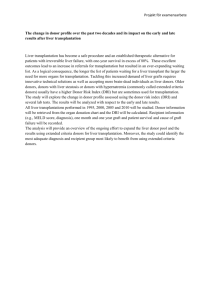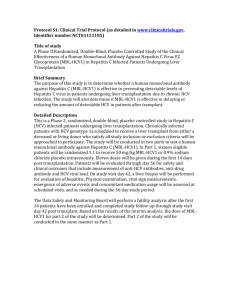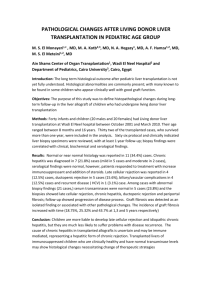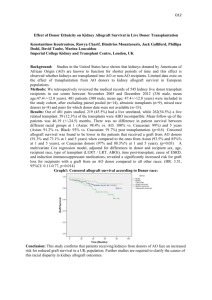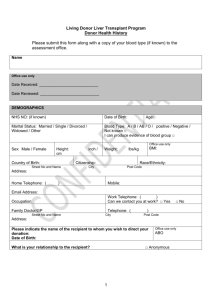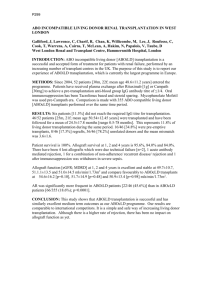ILTS 18th International Congress May 16
advertisement
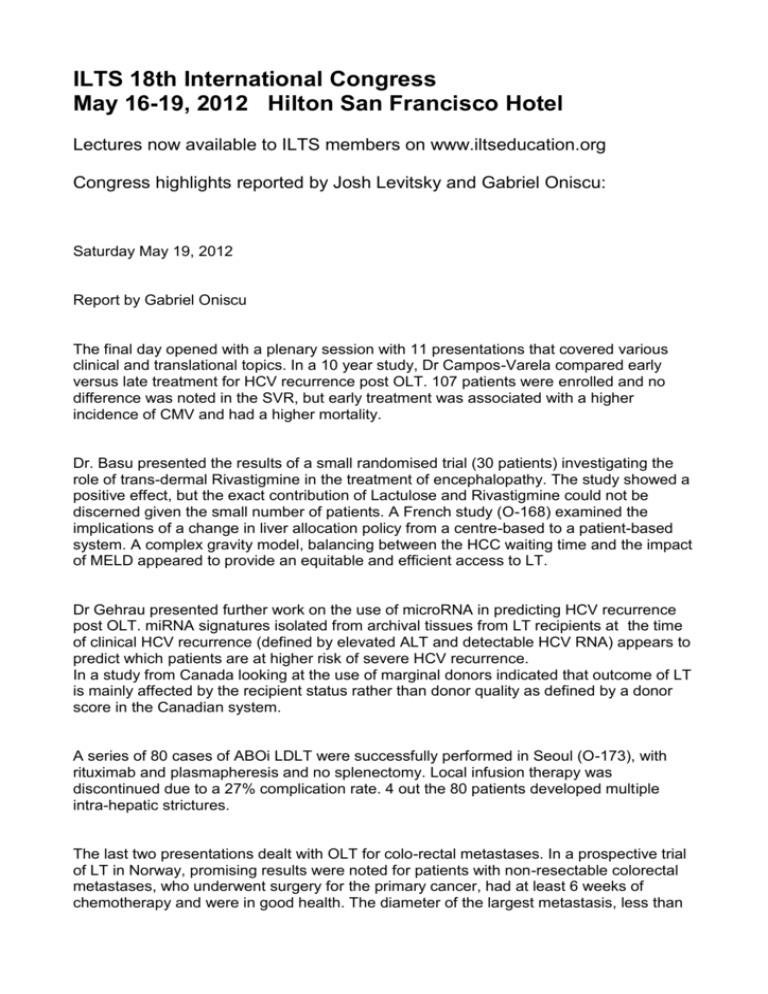
ILTS 18th International Congress May 16-19, 2012 Hilton San Francisco Hotel Lectures now available to ILTS members on www.iltseducation.org Congress highlights reported by Josh Levitsky and Gabriel Oniscu: Saturday May 19, 2012 Report by Gabriel Oniscu The final day opened with a plenary session with 11 presentations that covered various clinical and translational topics. In a 10 year study, Dr Campos-Varela compared early versus late treatment for HCV recurrence post OLT. 107 patients were enrolled and no difference was noted in the SVR, but early treatment was associated with a higher incidence of CMV and had a higher mortality. Dr. Basu presented the results of a small randomised trial (30 patients) investigating the role of trans-dermal Rivastigmine in the treatment of encephalopathy. The study showed a positive effect, but the exact contribution of Lactulose and Rivastigmine could not be discerned given the small number of patients. A French study (O-168) examined the implications of a change in liver allocation policy from a centre-based to a patient-based system. A complex gravity model, balancing between the HCC waiting time and the impact of MELD appeared to provide an equitable and efficient access to LT. Dr Gehrau presented further work on the use of microRNA in predicting HCV recurrence post OLT. miRNA signatures isolated from archival tissues from LT recipients at the time of clinical HCV recurrence (defined by elevated ALT and detectable HCV RNA) appears to predict which patients are at higher risk of severe HCV recurrence. In a study from Canada looking at the use of marginal donors indicated that outcome of LT is mainly affected by the recipient status rather than donor quality as defined by a donor score in the Canadian system. A series of 80 cases of ABOi LDLT were successfully performed in Seoul (O-173), with rituximab and plasmapheresis and no splenectomy. Local infusion therapy was discontinued due to a 27% complication rate. 4 out the 80 patients developed multiple intra-hepatic strictures. The last two presentations dealt with OLT for colo-rectal metastases. In a prospective trial of LT in Norway, promising results were noted for patients with non-resectable colorectal metastases, who underwent surgery for the primary cancer, had at least 6 weeks of chemotherapy and were in good health. The diameter of the largest metastasis, less than two years since primary tumour surgery, an elevated CEA pre-transplant and progressive disease at the time of transplant were associated with an inferior survival. The meeting concluded with a series of featured symposia, covering donor quality, longterm outcomes and recurrent disease in paediatric transplantation, techniques in living donor transplantation and disease transmission with OLT. It has been yet another successful meeting that provided a showcase of the current clinical and translational research in the field of liver transplantation. The meeting has raised the expectations for next year’s meeting and we look forward to reporting from Sydney. Friday May 18, 2012 Josh Levitsky reports.. Plenary Session II An excellent second plenary session followed another Vanguard debate. Dutkowski et al presented on an alternative to DRI for risk assessment in DCD. This BAR, which includes recipient factors, is validated as predictive of morbidity and mortality. Next, Ahn et al reported on 28 LDLT recipients who had the right gastroepiploic artery used for HA reconstruction, mainly for injured HA from prior therapy (TACE). No HAT was seen in these patients, arguing for the use of this vessel as an alternative. Yassen et al showed that using the RVEDV off a pulmonary artery catheter for fluid resuscitation had no different outcomes than using CVP intraoperatively, and patients often received unnecessary fluids. Dr. Fung reiterated the findings from the de novo EVR trial presented the day before, describing in further detail the TAC withdrawal group data, as despite that arm being stopped, most reached 12 months. While there was more rejection, renal function improved compared to the TAC maintenance arm. Dr. O’Leary presented an interesting study on de novo MHC Class II DSAs developing post-LT, and found an association with graft and patient survival if the DSA MFI >5000. Those with this high titer DSA more often had HCV-R and less had functioning grafts. Usually class I DSA rarely is de novo and does not persist, while class II DSA when preformed usually persists and more often occurs de novo. Dr. Orozco presented an interesting study showing MRE cutoffs of 2.6 and 2.8 for abnormal biopsy and >20% steatosis, respectively, in living donor evaluations. Thus MRE rather than invasive biopsy may be possible to evaluate acceptable living donor livers. Dr. Del Gaudio argued that liver resection for all patients with small HCC and MELD <11 can help select appropriate LT patients and be a bridge to LT. Finally, Andreani et al from King’s College showed no difference in mortality and HCVR fibrosis between SCD vs. ECD vs. DCD donors in HCV+ recipients. The afternoon concurrent session on recurrent disease began with a study comparing entecavir vs. lamivudine prophylaxis without HBIG after LT for HBV patients. Most cleared sAg with both LAM and ETV (90%), but some had reappearance without HBV DNA. HBV DNA suppression over time was equal in both groups (around 95%), although 17% had virological rebound with LAM due to drug resistance- all were treated successfully with additional therapy. This was not seen with entecavir. Ng et al reported data on specific microRNAs (miR 1246 in particular) to predict HCC recurrence and survival when tested very early after LT. microRNAs are highly stable in blood and body fluid (circulating) for use as biomarkers. Kendrick et al found no effect of using an ‘alcohol contract’ prior to LT in reducing recurrent ETOH use post-LT. Nadig et al showed impressive data demonstrating less HCV-R with complete steroid or induction avoidance. Two Italian papers showed the efficacy of subcutaneous HBIG when given later after transplant to replace IV or IM HBIG. When given weekly (500 IU/ml), this resulted in all patients having antiHBs titers >100 and no HBV recurrence (although all were on HBV antiviral therapy). The question is whether weekly dosing is necessary in favor of every other week or every month, like IV or IM dosing. The advantage is ease of administration and selfadministration. The last session of the day on HCV therapy timing/new agents was an interactive session. Tanaka (Toronto) et al presented on 245 patients undergoing antiviral treatment for recurrent HCV. Overall, SVR 51%, 41% in geno 1/4. 5 year survival for SVR and relapsers was much higher than NR. In the MV model of risk of death: SVR 0.07 and relapse 0.184, showing the power of virological response on outcomes. Tamura et al presented on preemptive AV therapy in LDLT recipients in Japan after a short period of stability (30 days)splenectomy was performed. Impressive SVR were achieved at 46% (75% geno 1), arguing for the use of pre-emptive therapy, although treatment was extended for nearly 2 years. Next, Aguilera et al analyzed if antiviral therapy at an earlier or later stage of fibrosis impacted response rates and survival. 114 patients were analyzed, one half had F3 or greater, the other less. SVR associated with improved histology in 75%, where NR was only 50%. The impact in survival is more evident in patients with less stages of fibrosis who get SVR, not the F3/4. Shin et al reported on 12 patients receiving triple therapy with PEG/RBV/TPV. 3 had FCH and expired. 4 failed due to early non-response. 3 currently on therapy and negative, 2 finished therapy and had SVR but had AIH after telaprevir stopped- possibly related to reduction in tacrolimus levels. Adverse effects were similar to pre-transplant, i.e. anal pain, rash, anemia. Overall 42% achieved SVR and 56% achieved SVR who did not discontinue therapy. And from Gabriel Oniscu.. Dr Lanier gave an excellent state of the art lecture on the role NK cells. He provided an overview of the function of NK cells in the liver, highlighting the protective role against viral infections such as CMV infection in mouse research and human clinical setting. In the first part of the lecture, Dr Lanier presented the laboratory work that confirmed that NK cells expand during CMV infection and are self-renewing. These long-lived “memory” NK cells protect against CMV better than “naïve” NK cells, expand >100 fold in the liver and contract after the antigen is gone but have the ability to be reactivated after second exposure. The second part of the lecture focused on the role of NK cells in humans. Humans NK cells express the activating CD94-NKGC receptor and respond to CMV infection. The frequency of CD94-NKGC NK cells appears to be constant but expands after reactivation in immunosuppressed patient. Finally, Dr Lanier touched upon ongoing research looking at Killer cell Ig-like receptors (KIR) in human NK cells and their role in clearing the HCV virus. Featured symposium 3 focused on advances in HCC treatment. Dr Ravaioli reported that TACE or RFA are accepted pre-OLT treatments, whilst new therapies such as sorafenib are currently under investigation. The role of pre-OLT liver resection is still under debate, but liver resection could save liver grafts and allow the understanding of the biology of HCC and planning of treatment. Dr Wiesner highlighted that current evidence suggests that CNIs increase the risk of HCC recurrence. mTOR inhibitors appeared to reduce the risk of recurrence as suggested by the 14 low level evidence (3b-4) publications on the topic (2002-2010). Currently there is a singe meta-analysis that showed a higher survival and lower HCC recurrence with mTOR inhibitors, but overall, there is not enough strong evidence to support a recommendation for mTOR use in HCC patients. Dr Yao discussed numerous proposed expanded criteria but highlighted that the number of patients that were in fact outside accepted Milan criteria in these publications was small. The conflict between transplantation for HCC with expanded criteria and the non-HCC patients on the waiting list was presented in the context of the US waiting list dynamics. Preliminary UCSF data appears to indicate that down-staging achieves a 90% disease free survival at 5 years, with a 5-years intention to treat survival of 56%. Several markers predicting recurrence are currently explored (albumin mRNA, circulating cancer stem cells, PIVKA II). As usual, the video session was a showcase of liver transplantation surgical advances and proved extremely popular with the surgical constituency of the society. Prof Lee from Asan, Korea presented a complex LDLT with pancreatico-duodenectomy for a hilar cholagiocarcinoma. This case required complex portal and venous outflow reconstruction and arterial inflow via the GDA. In another presentation from Asan, a patient with advanced multifocal HCC underwent down-staging followed by an LDLT performed after IVC was replaced with an artificial graft. New artificial orifices for RHV and MHV/LHV were created in the IVC graft to allow graft implantation. The approach to portal vein thrombus in LDLT recipients generated discussions regarding the optimal approach following a presentation from Dr Kato from Japan. The extended criteria session features 9 papers. In a single centre experience from France (O-100), the authors advocated the routine use of elderly donors (>75 years of age) as there was no increase in primary non-function or postoperative complications and recipients achieved a comparable outcome with patient who received younger donor livers. A translational paper from Holland (O-102) reported that microRNA recovered from preservation solution could be used to evaluate the quality of donor liver. MicroRNA is released differently by DBD and DCD grafts and are more predictive of graft quality compared to liver biopsy. The Cleveland group presented a small series of full right-left split liver transplants (O103). Patient and graft survival are good, but biliary leaks and strictures were present in 20-30% of cases highlighting the technical difficulties of these procedures. A single centre study from Birmingham, UK (O-104) showed no difference in the outcome of DCD donors who suffered an out of hospital arrest prior to donation, suggesting that these donor could successfully increase the donor pool. The interactive concurrent sessions were an innovation for this year’s programme. The format of these sessions consisted of an overall introduction from the moderators, with questions for the audience, followed by the paper presentations and a final vote from the audience. The prioritisation/expanding sharing session was thought provoking and featured seven presentations dealing with complex organ sharing issues around the world. The first paper in the session (O-158) suggested that waiting time rather than donor organ quality influences the outcome of transplantation in high MELD patients. Wider organ sharing was the topic of a paper from UK (O-160) which showed that wider regional sharing of organs to facilitate transplantation of patients with MELD>25 is feasible and allows quicker transplantation with a good outcome. A study from Argentina (O-161) highlighted a 50% discard rate of the donor livers and identified several factors responsible for the current practice. In presentation O-164 it was suggested that HCC patients in the US receive too many points and this may be detrimental to the non-HCC patients, given the much lower dropout rate from the list when compared with similar MELD non-HCC patients. Thursday May 17, 2012 Josh Levitsky reports.. A number of interesting highlights came from the meeting’s first Plenary session. Sebagh et al. reported on 20 year biopsies of LT recipients, showing that 90% had histological abnormalities and most had hepatic structural changes. Non-invasive testing (Fibrotest, Fibroscan) had good NPV but poor PPV for detecting fibrosis. Reduction in IS was less and increase in IS more in those who had biopsies, although it is unclear if this impacted outcomes. Taner et al discussed the importance of reducing asystole wait time before incision and more rapid incision to crossclamp time, to reduce ischemic biliary strictures in DCD transplantation. Andres et al reported on a score/calculation for survival after retransplantation for HCV, using donor/rec age, creatinine, inr, albumin, Interval of 1st and 2nd LT. This could hopefully predict whether re-LT is optimal or not. Two pediatric reports showed that using left lateral grafts from living vs. deceased donors led to similar outcomes, with more graft losses due to HAT/PNF with deceased (Herden et al); the other report showed good outcomes of 223 split LT recipients (Platto et al). Teperman et al. reported on a multicenter/national study on ELAD for either ETOH hepatitis or acute on chronic liver failure. ELAD uses C3a human liver cells immortalized from hepatoblastoma line and plasma ultrafiltration; the cells synthesize proteins (albumin, AFP), have active cytochrome p450, and metabolize toxins. 29 ELAD, and 33 control were randomized. While there was no difference in survival for either group, there was a trend in ETOH hepatitis and further ELAD studies in this group and acute liver failure are planned. Uchida et al reported their results of IS weaning in pediatric recipients, with a focus on those who required IS reinitiation. Follow-up biopsies in this cohort showed that 55% improved and 21% worsened fibrosis despite IS reinstitution. Finally, Minou et al reported on the use of sevoflurane anesthesia for donors during procurement. The use of this agent resulted in lower AST and less early allograft dysfunction than not using it, mostly in steatotic grafts. They also looked at discarded grafts that had biopsies pre and post sevoflurane and controls, and there was less centrizonal necrosis. Dr. Jeffrey Bluestone gave a terrific State of the Art Lecture on liver transplant immune tolerance. He stated that the goal is to “blindfold the immune system to prevent it from responding to all antigens, with the hope that the alloantigen response is preferentially affected.” He discussed documented clinical parameters associated with withdrawal success: longer time from LT, increased age, IS therapy without CNI- and that rejection can usually be easily reversed in such trials. He then turned to discussing the importance of Tregs in tolerance, with the population divided into natural (4-6% of CD4 population) vs. induced Tregs from naïve CD4 cells (by IL-10, TGF) usually at the site of inflammation. For Treg therapy, one would need to ablate alloreactive effectors donor-specifically in combo with donor-specific Treg infusion. In humans, Tregs can be isolated and expanded with antiCD3/28 beads, as well as using activated donor B cells to expand recipient Tregs. The afternoon began with a concurrent session on Immunosuppression. Everolimus therapy was the focus. De Simone et al reported on a large study randomizing over 700 LT recipients. EVL+ reduced TAC (at 1 month) had GFR 8-10 ml/min better than standard TAC at 1 year. The TAC withdrawal arm had to be stopped due to more acute rejection, so only the EVL + reduced TAC vs. standard TAC were studied. Proteinuria was higher at month 12 with EVL but only nephrotic in one case. The efficacy failure was comparable and actually the EVL + rTAC had fewer rejections than TAC alone. In this same study, Fischer et al reported no differences in wound healing, incisional hernias, and hepatic artery thrombosis with EVL and TAC. Schlitt et al reported better results with CNI discontinuation in favor of EVL, in 203 LT recipients. The GFR by MDRD improved and there was no difference in composite endpoints. However, twice as many EVL patients had to discontinue therapy than the CNI group. Next, Kaneku et al reported on 912 patients with pre-transplant available serum and found that 38% had a +DSA test. Higher rejection rates were seen with DSA+ (45% vs. 36%), mainly class II, and lowered by induction therapy. The same results were seen in the HCV+ subgroup. An informative late afternoon concurrent session on HCV was a highlight of the day. Saliba et al reported on the HCV subgroup in Dr. DeSimone’s study (above) and found that the composite efficacy failure, HCV viral load, and rates of HCV-related allograft fibrosis were similar with EVL and TAC, with improved kidney function with EVL. Unfortunately, only 50% of patients had one year liver biopsies. Villamil et al reported on a study of 43 patients with known HCV-recurrence who were randomized to continued CNI vs. switch to EVL, late after LT. Similarly, not all had liver biopsies performed. While the CNI group had increased fibrosis scores, the EVL group had reduced scores after 1 year on biopsy. There was no difference in inflammation. The Nebraska group reported on 14 patients with HCV-R treated with PEG/RBV and telapravir, at about 3 years post-LT. This group switched patients to cyclosporine and had 6 patients develop extended RVR (no SVR data yet). The dose of cyclo had to be lowered by 2-5x the original dose. While this looks promising, a number of patients had serious adverse events and side effects. The UCSF group (Flemming et al) reported an interesting study in which 50% of patients who did not achieve SVR on PEG/RBV therapy for post-LT HCV-r had stable/improved fibrosis scores following treatment, along with improved survival over those who had worsening fibrosis. This argues for treating patients with interferon even if virological response is not achieved, with the hope that fibrosis stabilizes. The Late Breaking Abstract session had an excellent meta-analysis of SRL use in HCC patients, focusing on 8 papers (6 retrospective, 2 prospective; 4 studies comparing SRL vs. CNIs). The 3 and 5 year survival was better and lower HCC recurrence rate with SRL. The patients benefiting the most were those with microvascular invasion and outside of Milan. However, randomized studies that are underway are needed to conclude that SRL therapy is beneficial in this setting. Finally, Peter Sayre of the ITN reported on an IS withdrawal study (Shaked et al) in which 275 LT recipients enrolled, 89 randomized to IS withdrawal, and 23 pending randomization. Up until now, very few patients are off IS therapy (tolerant). However, 2/3 could have a 50% reduction in IS therapy and 1/3 could tolerate a 75% reduction. Most rejection episodes were mild, reversible, and only a small number required steroid boluses. Gabriel Oniscu reports.. The rising star symposium featured 6 clinical and translational papers. Dr Herden from Germany discussed the implications of new allocation rules for paediatric liver transplantation in Eurotransplant, comparing 110 OLT pre- and 50 OLT postintroduction of the changes. Fewer reduced liver grafts were used since new allocation rules were introduced. There was a reduction in the number of deaths on the waiting list, but no difference in the 1 and 3 years graft and patient survival. Dr Giesbrand presented a clinical correlation between the radiological appearance of ischaemic cholangiopathy and the clinical outcome. Four patterns were identified: hilar strictures, multifocal progressive stenosis, centrifugal progressive stenoses and rapid progressive peripheral duct necrosis. A subset of patients had cholangiographic abnormality but no clinical symptoms. These patients had an inferior outcome, comparable with that seen in patients with frank cholangiopathy. Dr Gehrau from Virginia University presented a multigenic test as a surveillance tool for the development of HCC in HCV positive patients. 69 patients with (24) and without HCC (45) had non-tumour cirrhotic tissue signatures tested. 17 genes were identified as having a high diagnostic performance and were able to correctly classify 81% of the samples. A proteomic non-invasive analysis is now investigated by this group. Dr Coilly from Paris discussed the safety and efficacy of a triple therapy regimen using protease inhibitors (Boceprevir or Telaprevir) for severe Hepatitis C recurrence after OLT in 28 patients enrolled in 5 French transplant centres. At 8 weeks, 56% of Boceprevir patients and 70% of Telaprevir patients achieved a complete virological response. Anaemia was the most common side effect and significant reductions in immunosuppressive doses were required. Dr Salvalaggio discussed the relationship between the MELD score, post-operative complications and resource utilisation. 580 primary adult full size grafts were studied according to the MELD at the time of transplant. High MELD patients have more infectious and renal complications, similar re-admission rates and require significantly more resources in the postoperative phase. Dr Xiaobo Yu presented a correlation between the costimulatory molecule B7-H3 genetic polymorphism and acute rejection (AR) in OLT. Of the 159 patients studied, 22 had a biopsy proven rejection. SNP at rs2127015 was an independent predictor of AR in a model that included HBV and fulminant failure etiology and had a sensitivity of 67.2% and specificity of 77.3%. Progress around the world symposium offered an international perspective on current developments in liver transplantation. Dr Soin presented the progress in India where 44 liver transplant centres have been approved (3 performing > 130 transplants/year). The vast majority of transplants are LDLT whilst deceased donor transplantation is underutilised. 7 living donor deaths have been reported in India. Other advances such as swap programme and ABOi OLT are currently being developed. Prof Zheng presented the living donor experience in China. 1128 adult LDLT have been perfomed in China with 86% 1-year survival rate. HCC is a common indication and a total tumour diameter of <8 cm or > 8cm with AFP<400 are the accepted criteria in Hangzhou. Dr Czerwinski presented a Polish perspective. DBD and LD are established and although the law allows DCD donation, currently there is no DCD programme. 2466 adult and 488 paediatric OLT have been performed since 1987. LDLT is performed primarily for paediatric recipients with only a small number of adult LDLT being performed so far. Dr Tokat presented the status of liver transplantation in Turkey. Several steps (coordinator network, hospital payment, cost cover of transplantation by the government) have been introduced to promote deceased organ donation. Living donation has also been regulated and unrelated transplants are allowed only for Turkish citizens to prevent organ trafficking. As a result, over 900 transplants have been performed in 2011 (2/3 LDLT). There are 39 transplant centres, 4 of them performing more than 100 OLTs per year. Dr Ferraz-Neto presented a South American update. Currently there are 91 active liver transplant centres in South America, 5625 patients on the waiting list and just over 2000 transplants performed in 2010. The living donor concurrent session featured 9 presentations. Among the papers presented, Dr. Song reported the 15-year experience from the Asan Medical Centre in Korea. Over 2500 LDLTs (largest series in the world) have been performed with an overall 4.8 % in-hospital mortality (3.2% in 2011) and 90.4% and 78.7% 1-year and 5-year survival. The donor morbidity has decreased from around 10% for the right lobe donation in the early stages of the programme to around 2% (irrespective of type of graft), with no donor mortality in 2819 donors. Dr Waki reported that post-transplant HLA class II antibodies as well as DSA class II antibodies were more commonly seen in patients with acute rejection episodes post LDLT, although a causal relationship was not clear. Dr Kakodkar proposed, in a study of 30 living donors, that infra-red spectroscopy with indocyanine green injection is useful to identify small (< 5 mm) accessory hepatic veins that require reconstruction due to the lack of collateralisation, improving the outflow of the graft and avoiding congestion. Dr Valdecasas highlighted the importance of portal flow in the aetiology of SFSS and that porto-caval shunt flow measurements predict the need for inflow modulation. The surgical techniques and complications session featured 10 papers. In a prospective randomised double blind placebo trial, Dr Troisi et al studied the effect of somatostatin on graft inflow modification and IRI. 15 patients with a PVP> 15 mmHg were randomised to receive somatostatin or placebo. In the 9 patients who received somatostatin, there was a significant reduction in the portal pressure, but there was no difference in the IRI as measured by AST /ALT levels. In a retrospective analysis of 91patients with pre-transplant PV thrombosis, Dr Francoz investigated the need for long-term anticoagulation to prevent re-thrombosis following OLT. At the time of surgery 54 patients had partial PVT (despite anticoagulation whilst on the waiting list). However, the study suggested that restoration of adequate portal flow is sufficient to prevent re-thrombosis, when anatomical portal reconstruction can be achieved. Wednesday May 16, 2012 SATELLITE SYMPOSIUM: BALANCING RISK IN LIVER TRANSPLANTATION DEFINING RISK: THE RECIPIENT PERSPECTIVE Report by Josh Levistsky The ILTS 2012 San Francisco meeting began with a session on defining risk, the Recipient Perspective. Dr. Cameron went through multiple scenarios in which the futility of liver transplantation may be in question, including recipients with high MELD, retransplantation, recurrent HCV, and acute liver failure. He pointed out that MELD was designed for pre-LT survival and not to determine the chance of post-LT survival or LT futility. He discussed the SOFT score, which may be better at defining poor post-LT survival. Retransplantation also might be futile if performed in a high MELD patient and/or after multiple transplants. The same goes for HCV recurrence, particularly if there is a short interval between subsequent transplants. Finally, acute liver failure models predict who will die without LT, not with transplant which is the key to determining futility. Dr. Berenguer and Dr. Stock next discussed HCV retransplantation and HIV/HCV transplantation, respectively. Most registries have shown the 5-year survival barely reaches 50% in HCV retransplantation. The main reluctance is organ scarcity and poorer results for RT in HCV in select candidates (worse if < 1 year post-OLT, older age of donor/recipient, renal impairment, high MELD>25). Better outcomes with retransplantation for HCV may occur if one could limit donor age, preservation injury, and rejection, control DM, and achieve SVR with AV therapy. The US trial showed worse patient and graft outcomes in HIV/HCV+ LT recipients. They had higher wait-list mortality, worse post-LT survival, more severe recurrent HCV, poor response to HCV therapy, and more rejection. The higher graft loss was due to MOF and sepsis rather than recurrent HCV. Predictors of graft survival: HIV+ and AR, the latter reflecting dysregulated immune responses. To improve results, he suggested not using HCV+ donors (did worse), low BMI<20, and protease inhibitor-based HIV regimens given drug interactions. Dr. Busuttil gave a comprehensive lecture on LT for non-HCC liver malignancies. For cholangiocarcinoma, 2/3 are hilar, only 10% have known risk factors, and there is no screening test. The goal for resection is clean margins (R0). While early results were suboptimal (2 yr survival 20-30%), the Nebraska and Mayo experiences of transplanting early stage hilar CCA with radiation, 5FU, then transplant has resulted in high 5 year survival. At UCLA, there is a protocol for intrahepatic cholangio using 5FU, capecitibine, resulting in good 5 year survivals. He then discussed neuroendocrine tumors metatastasizing to liver. While liver resection is ideal, LT may offer benefit in nonresectable cases, assuming the Ki67 proliferative index is low and the tumor is from a nonpancreatic primary. Finally, Dr. Nadim discussed the controversial topic of combined liver-kidney transplantation, highest in regions with high MELD scores prior to LT (1,5,7). The main problem is that UNOS doesn’t capture duration or accurate cause of CKD in patients not on hemodialysis (30%). She discussed 4 main questions: 1) How to define AKI in this population? This might be the same RIFLE criteria as non-liver population, with the exception being the discrepancy between eGFR and ‘true’ GFR (by iothalamate) in low GFR patients; 2) What duration of AKI impacts post-LT outcomes? This is unclear as well as the duration of HD; 3) Etiology of AKI- does it matter? She presented her data showing patients with ATN had significantly less renal recovery post-LT than HRS patients, particularly in the first 6 months; 4) What GFR cut-off justifies SLK? This is unclear and most use time on HD and inaccurate estimates (MDRD4) and not MDRD6 or iothalamate. A recent consensus summit proposed SLK in patients with persistent AKI > 4 weeks and/or CKD > 3 months. Dr. Venick discussed retransplantation for the nonadherent adolescent in the last session “Interactive, Cased-Based Analyses in Risk Management”. The definition of adherence includes following medication regimens and physician advice, and going to clinic appointments regularly. Unfortunately, there is no consensus on how to best measure adherence, such as direct questioning, counting missed appointments, pill counting/medication refill rates, electronic monitoring, and fluctuating IS blood levels. As SD deviates more (>2), the probability of late rejection and graft loss rises exponentially, up to 50% of adolescents. Risk factors for nonadherence include socioeconomic problems, PTSD, lack of support, and abrupt transition of care from peds to adult. Young adults may not be medically competent, educated, or supported. The main question asked was whether different criteria should be used for peds vs. adults (i.e. 6 month adherence period, like the 6 month sobriety rule). Ultimately, techniques to improve compliance, such as increased clinic visits, education, simplifying regimens, and using a multidisciplinary team, should help minimize the impact of nonadherence. Dr. Mathurin then addressed the controversy surrounding LT for alcoholic hepatitis. He stressed that the time-tested Maddrey score is still the best determinant of mortality, although the Lille model was highly predictive of survival following corticosteroid administration, particularly null responders. Ultimately, he showed data that LT for alcoholic hepatitis had favorable outcomes compared to alcoholic liver disease (chronic) and other outcomes. He stressed that his NEJM study only included patients who were considered LT recipients based on staff consensus, lack of comorbidities, good social integration, supportive family members, and positive psychiatric evaluation. Dr. Charlton then reviewed a growing problem of LT for NASH and the possibility of disease recurrence. However, prior data showed that patient/graft survival did not correlate with high BMI, rather more morbidity (LOS, cost, complication rates). He urged the audience to consider simultaneous sleeve gastrectomy which is entirely restrictive and non-malabsorptive. Ultimately, only 5% of NASH recurrence leads to cirrhosis in 5 years post-LT, not affecting graft loss. However, other comorbidities ensue and cause 2/3 of late deaths unrelated graft dysfunction (infection, CV disease, malignancy, renal disease) which will be posted on-line. Finally, Dr. Tokat discussed the results of a survey of living donors and compared them to the audience responses. The principles for LDLT include: right to donate, autonomy, free from coercion, no maleficence, beneficence, and reasonable risks. Coercion comes from many forms, from spiritual beliefs/religion, family members/relatives, friends/community, doctors and health workers and even the recipients. His survey showed that Turkish LDLT donors had no regrets and would donate again. The good outcomes are the main inspirational factor for donors. 25% said someone objected to these donations, most often parents/siblings less, but this did not affect relationships. DEFINING RISK: THE DONOR PERSPECTIVE Report by Gabriel Oniscu In keeping with the overall theme of the symposium, the focus of discussion in the second session concentrated on the risks associated with donor livers. Dr Kyung-Suk Suh discussed the topic of living donors, asking the question of how far can we push the limits, particularly in countries where deceased donor liver transplantation is still scarce. His talk covered several topics where limits have been pushed with the development of living donation: living donor age, donor-recipient relationship, donor anatomy, donor BMI, the importance of residual liver volume (RLV) and graft to recipient weight ratio (GRWR), donor liver steatosis as well as surgical techniques (open, laparoscopic or hybrid). One of the current challenges is what represents an acceptable MELD for a successful LDLT. Dr. Guerara explored the limits of deceased liver donation. The endeavours in deceased donation must strike a balance between a successful outcome and a reduction in waiting list mortality and innovations to increase organ availability. A fundamental principle that still awaits a clear definition is the concept of extended criteria donors. To date the definition of extended criteria is based on the risks incurred by the recipient, including the risks of early graft failure or dysfunction, viral or tumour transmission. The use of elderly donors or hepatitis C positive donors has been advocated in patients with hepatitis C as they achieve good results. Dr Guerara reviewed strategies to improve DCD utilisation, strategies for ischaemic preconditioning and various preservation techniques. Cold machine preservation is currently explored, as it may mitigate ischaemia reperfusion injury, may provide a better preservation of microvasculature and allow targeted delivery of therapeutics. Normothermic bench perfusion is pioneered and has great promise as a reconditioning technique. Normothermic regional perfusion (NRP or NECMO) has great potential to evaluate liver function during the resuscitation process. Dr Fung discussed innovation and outcomes in donation after cardiac donation. Currently, DCD transplantation requires more resources, but the outcome is inferior to DBD liver transplantation, with a higher risk of primary non-function and ischaemic cholangiopathy (10 fold increase). Better outcomes can be achieved with stricter donor selection criteria (young age, short warm ischaemic time , short cold ischaemic time). Several interventions (minimisation of warm ischamic time, utilisation of sevoflurane in the preagonal phase, the length of acceptable no-touch period, procurement technique with rapid organ removal, organ preservation solutions and techniques and IRI minimisation interventions) were reviewed. Split liver transplantation was explored from a paediatric and adult perspective. Dr. McDiarmid highlighted the need to increase split liver transplantation to reduce paediatric waiting list mortality. The outcome of split liver transplantation is comparable with whole organ transplantation in the paediatric setting. An adequate utilisation of liver splitting could potential resolve the need for paediatric liver transplantation in the US, but cooperation and organ sharing is essential to ensure the success of such a programme. Dr Yersiz explored liver splitting from an adult perspective. Whilst splitting for adult and paediatric recipients is well established, full right-left split (split for two adult recipients) has lagged, with poorer results. The development of LDLT techniques have resolved some of the technical issues and increased the use of this approach, particularly in Europe. Despite this, split liver is still underutilised. GLOBAL PERSPECTIVES ON INNOVATION AND OUTCOMES Report by Gabriel Oniscu Dr. Freeman opened the third session with a talk on taking risks in the age of data transparency, discussing the concepts of absolute risk and relative risk. An important concept in liver transplantation is the one of competing risks, particularly relevant when one looks at the waiting list assessments. Risk calculations are useful but must be interpreted within context. Nevertheless, these data are important to allow an informed shared decision to be taken together with our patients. Prof. Rela presented a South-Asian perspective on living donor liver transplantation. The estimated demand for liver transplantation in India is approximately 100,000 per year, but progress has been slow due to poor legislation, poorly equipped hospitals, poor organisation and less awareness and enthusiasm for organ donation. A better organisation supported by regulatory stipulations is needed to support the growth of the deceased donor programmes particularly in the state sector. Currently, 88% of transplants are LDLT but there is a need for a multidisciplinary approach, clinical governance, data collection and integrity, mentoring, research and affordability. Professor Sugawara presented an East-Asian perspective of LDLT, reviewing the selection and evaluation criteria in the Japanese programmes, as well as the surgical techniques, outcomes and complications. ABO incompatible transplantation has been successful in Japan due to a treatment strategy which includes plasma exchange, rituximab and splenectomy. Prof SG Lee reviewed the desensitisation strategies in ABOi LDLT. A modified approach with no splenectomy, local infusion therapy and plasma exchange has been successfully employed in Korea and subsequently modified to include rituximab, PE, IVIG, standard immunosuppression and no local infusion (thus avoiding the complications associated with this procedure). This protocol has achieved comparable results with ABO compatible LDLT. To avoid the risks of ABOi in selected cases, a donor exchange LDLT programme has been introduced in Korea. A principle of equality underpins this programme and pairs are matched for GRWR and indication, but requires significant resources to enable all operations to be performed simultaneously. Dr Wenger closed the session with a talk on the ethical principles underpinning the allocation process. The current allocation gives priority to the sickest but it does not necessarily provide the best organ utilisation to achieve a maximum number of years of life gain. A more important outcome for the patients is the health-related quality of life and that should be included in any future models of organ allocation.
